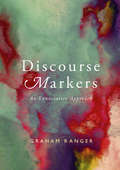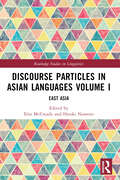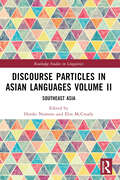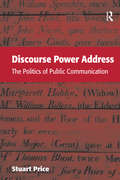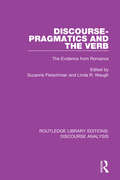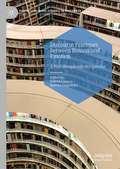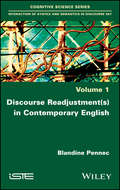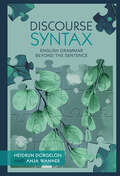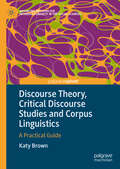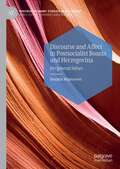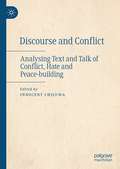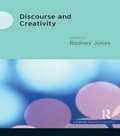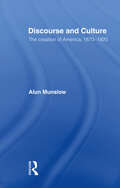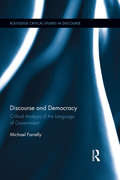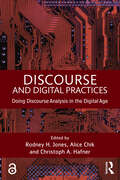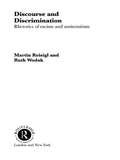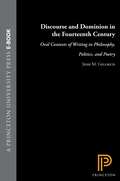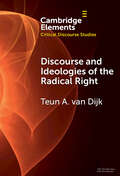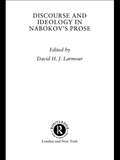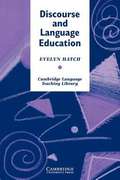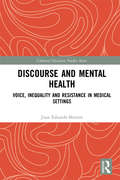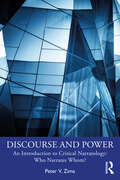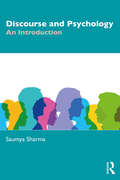- Table View
- List View
Discourse Markers: An Enunciative Approach
by Graham RangerIn our everyday speech we represent events and situations, but we also provide commentary on these representations, situating ourselves and others relative to what we have to say and situating what we say in larger contexts. The present volume examines this activity of discourse marking from an enunciative perspective, providing the first English-language study of the highly influential Theory of Enunciative and Predicative Operations. This semantic/pragmatic theory is popular among academics who specialize in linguistics, discourse analysis, translation studies and didactics in France, but has not yet been widely adopted elsewhere. The tools of this theory are applied to a variety of specific discourse markers in contemporary English and semantic hypotheses are tested using the data-based approach of corpus linguistics. This book therefore provides an English-speaking readership with the keys to understand the theory underlying the author’s analysis of a selection of markers (‘anyway’, ‘indeed’, ‘in fact’, ‘yet’, ‘still’, ‘like’ and 'I think'). This book will provide a valuable resource for students and researchers in linguistics with an interest in discourse markers, natural language argumentation, formal semantics, the interfaces between syntax, semantics and pragmatics, linguistic theorisation and French – or “poststructural” – models of discourse analysis.
Discourse Particles in Asian Languages Volume I: East Asia (Routledge Studies in Linguistics)
by Elin McCready Hiroki NomotoThis is the first of two volumes of research on discourse particles focusing exclusively on the languages of Asia from the perspective of formal as well as non-formal semantics and pragmatics. Within linguistics, there has been a great deal of interest in discourse particles, especially within semantics and pragmatics. The term ‘discourse particles’ has been used to cover a broad range of phenomena, including such things as ‘sentence-final particles,’ ‘discourse adverbs,’ and other related phenomena. However, most research in the area (particularly within formal semantics and pragmatics) focuses on a restricted set of languages, and there is little consensus on the proper formal treatment of particles, partly due to the limited range of data available. In recent years, there has been extensive development of the formal approach to discourse particles, which often treats these words as devices for marking information updates. It is also vital to extend this data to non-Western languages like Japanese, Korean, or Chinese. This edited volume includes chapters on Japanese, Mandarin, Tagalog, Kimaragang Dusun, Malay, Singlish, Thai, and Vietnamese. The chapters are informed by recent theoretical work in formal semantics and pragmatics relating to the meaning of particles. The collection contributes to our theoretical understanding of the meaning of discourse particles and to empirical knowledge of discourse particles in the languages of Asia. It will be of interest to postgraduate students and scholars of semantics and pragmatics.
Discourse Particles in Asian Languages Volume II: Southeast Asia (Routledge Studies in Linguistics)
by Elin McCready Hiroki NomotoThis volume is the second in a two-part collection of research on discourse particles focusing exclusively on the languages of Asia from the perspective of formal as well as non-formal semantics and pragmatics. Despite increasing interest in discourse particles, most research in the area (particularly within formal semantics and pragmatics) focuses on a restricted set of languages, and there has been little consensus on the proper formal treatment of particles. The term "discourse particles" has been used to cover a broad range of phenomena, including such things as "sentence-final particles," "discourse adverbs," and other related phenomena. In recent years, there has been extensive development of the formal approach to discourse particles, which often treats these words as devices for marking information updates. It is vital however, to extend this data to non-Western languages, like Malay, Thai, or Vietnamese. These two volumes are the first to give an exclusive focus on particles in non-European languages (in this case, Asian languages), from the perspective of formal and non-formal semantics and pragmatics. This second volume includes chapters on Tagalog, Kimaragang Dusun (Malaysia), Malay, Singlish (Colloquial Singapore English), Thai, and Vietnamese. The chapters are informed by recent theoretical work in formal and non-formal semantics and pragmatics relating to the meaning of particles. The collection contributes to our theoretical understanding of the meaning of discourse particles and to empirical knowledge of discourse particles in the languages of Asia. It will be of interest to postgraduate students and scholars of semantics and pragmatics.
Discourse Power Address: The Politics of Public Communication
by Stuart Price'Discourse Power Address' identifies the existence of 'directive' address, a form of strategic communication which is employed in a number of dominant practices, including Advertising, Politics, Public Relations and Corporate representation. Stuart Price argues that the simulation of intimacy in authoritarian address masks a drive to power, in which the creation of propositions by powerful social actors is based on the 'timeliness' of utterance rather than any real adherence to truth or genuine explanation. Election broadcasts, political speeches, TV commercials and corporate advertisements are all scrutinised in order to evaluate competing perspectives on the creation and circulation of meaning; particular reference is made to theories of discourse, ideology and address. In the course of his argument, the author proposes an original method for determining how authoritarian address attempts to make an impact on audiences. Providing a cross-disciplinary contribution to the fields of Communication, Language, Media and Political Studies, this book provides an original, clear-sighted contribution to the debate on language and power, and will provide an essential resource for lecturers, researchers, students, activists and policy-makers.
Discourse Pragmatics and the Verb: The Evidence from Romance (RLE: Discourse Analysis)
by Suzanne Fleischman Linda R. WaughFirst published in 1990, this collection investigates grammatical categories associated with the verb as they are used by speakers and writers in real discourses and texts. Focusing on tense, aspect, mood, and voice in French, Spanish, and Italian, each chapter underscores the importance of context in our understanding of how grammatical categories work. Above and beyond their basic ‘grammatical functions’, categories of the verb are shown to operate in such capacities as structuring information in discourse, establishing point of view in a text, and creating textual cohesion. Importantly, this volume reflects the crucial role discourse-pragmatics factors play in our interpretation of the meanings of categories of grammar.
Discourse Processes between Reason and Emotion: A Post-disciplinary Perspective (Postdisciplinary Studies in Discourse)
by Patrizia Anesa Aurora FragonaraThis book addresses different forms of discourse by analysing the emergence of power dynamics in communication and their importance in shaping the production and reception of messages. The chapters focus on specific cognitive aspects, such as the verbal expression of reasoning or emotions, as well as on linguistic and discursive processes. The interaction between reasoning, feelings, and emotions is described in relation to several fields of discourse where power dynamics may emerge and includes, among others, political, media, and academic discourse. This volume aims to include representative instances of this heterogeneity and is deeply rooted, both theoretically and methodologically, in the acknowledgment that the investigation of the complex interaction between reason and emotion in discursive productions cannot be exempt from the adoption of a multi-disciplinary perspective. By providing a critical reflection of their methodological decisions, and describing the implications of their research projects, the contributors offer insights which are relevant for students, researchers, and practitioners operating in the broad field of discourse studies.
Discourse Readjustment(s) in Contemporary English
by Blandine PennecThis study examines the linguistic tools which enable speakers and writers to propose adjustments and re-adjustments of the sentences they’ve just produced, as well as the goals they fulfil by doing so. We examine corrections, reformulations, specifications, modifications of points of views and link them with discursive strategies. (Re)-adjustments can be made in order to express oneself in a better way, to favor comprehension by adapting to the addressee, to structure one’s intervention, to play on the potentialities of language (polysemy, homonymy, ambiguity), to mention the main purposes associated with the use of those devices. The study focuses on the markers associated with those strategies. Therefore, it links the syntactic, semantic and pragmatic levels.
Discourse Syntax: English Grammar Beyond the Sentence
by Heidrun Dorgeloh Anja WannerDiscourse Syntax is the study of syntax that requires an understanding of the surrounding text and the overall discourse situation, including considerations of genre and modality. Using corpus data and insights from current research, this book is a comprehensive guide to this fast-developing field. It takes the reader 'beyond the sentence' to study grammatical phenomena, like word order variation, connectives, ellipsis, and complexity. It introduces core concepts of Discourse Syntax, integrating insights from corpus-based research and inviting the reader to reflect on research design decisions. Each chapter begins with a definition of learning outcomes, provides results from empirical articles, and enables readers to critically assess data visualization. Complete with helpful further reading recommendations as well as a range of exercises, it is geared towards intermediate to advanced students of English linguistics and it is also essential reading for anyone interested in this exciting, fast-moving discipline.
Discourse Theory, Critical Discourse Studies and Corpus Linguistics: A Practical Guide (Advancing Methods for Interdisciplinarity in the Social Sciences)
by Katy BrownThis book provides a practical guide to a novel framework combining three diverse traditions within the field of discourse studies: Poststructuralist Discourse Theory, Critical Discourse Studies and Corpus Linguistics. By first covering a philosophical and conceptual overview to illustrate their compatibility, followed by detailed steps for applying them analytically within research projects, it offers an accessible framework for researchers and students interested in mixed-methods approaches to discourse analysis. The way that the book introduces both the core components of each tradition and a comprehensive framework for their amalgamation means that it will strongly interest both newcomers to the field and more experienced discourse analysts. The piece aims to act as a stimulus for greater dialogue between the traditions and to encourage further development of this unique combination of methodologies.
Discourse and Affect in Postsocialist Bosnia and Herzegovina: Peripheral Selves (Postdisciplinary Studies in Discourse)
by Danijela MajstorovićThis book examines the making and breaking of peripheral selves in and from postsocialist Bosnia in an empirically rich self-reflexive account of politico-economic and ideological developments. Through world systems and postcolonial theory, historical and new materialist optics, discursive and affective analytical registers, and various qualitative methodological choices, the author analyzes peripheral subjectivity in connection to global proletarianization, as well as past and present resistance via social and personal movement(s). She refers to past Yugoslav socialist and anticolonial struggles as well as more recent ones, including the social justice and feminist collective, engaging with workers’ and women’s struggles in postwar Bosnia and the Justice for David movement. Finally, she analyzes the lives of new third-wave Bosnian migrants to Germany post-2015, placing them in juxtaposition with non-European migrants in Bosnian reception centers and exposing labor and race, border struggles and market as new variables for studying selves in this particular context. Writing about “situated knowledge” and “politics of location,” the author stresses the importance of strong affective ties within researcher-researched assemblages urging for deeper coalitions and solidarity among various peripheral, power-differentiated communities. This book will be of interest to readers with backgrounds in linguistics, sociology, post-Yugoslav history, cultural studies and anthropology.
Discourse and Conflict: Analysing Text and Talk of Conflict, Hate and Peace-building
by Innocent ChiluwaThis edited book analyses the relationship between discourse and conflict, exploring both how language may be used to promote conflict and also how it is possible to avoid or mitigate conflict through tactical use of language. Bringing together contributions from both established scholars and emerging voices in the fields of Discourse Analysis and Conflict Studies, it argues for a discourse approach to making sense of conflict and disagreement in the modern world. ‘Conflict’ is understood here as having a national or global focus and consequences, and includes verbal aggression and hate speech, as well as physical confrontation between political and ethnic groups or states over values, claims to status, power and resources. Themes explored in the volume include the language of conflict, hate speech in online and offline media, and discourse and peace-building, and the chapters examine various national contexts, including Lithuania, Brazil, Belgium, North Macedonia, Sri Lanka, the USA and Afghanistan. The chapters cover conflict-related topics within the fields of Political Science, International Relations, Sociology, Media Studies, and Applied Linguistics, and the book will be of interest to students, researchers and experts in these and related fields, as well as professionals in conflict and peace-building/peace-keeping.
Discourse and Creativity
by Rodney JonesDiscourse and Creativity examines the way different approaches to discourse analysis conceptualize the notion of creativity and address it analytically. It includes examples of studies of creativity from a variety of traditions and examines the following key areas, how people interpret and use discourse, the processes and practices of discourse production, discourse in modes other than written and spoken language, and the relationship between discourse and the technologies used to produce it.Discourse and Creativity combines a forward-thinking and interdisciplinary approach to the topic of creativity; this collection will be of great value to students and scholars in applied linguistics, stylistics, and communication studies.
Discourse and Culture: The Creation of America, 1870-1920
by Alun MunslowWritten history is literary artifact: taking this as its starting point, Discourse and Culture argues that the Foucauldian concept of the shifting scale of linguistic and historic values must be the central focus for a new interpretation of American culture and ideology. Six major American historical figures are evaluated as products of the conflict between subordinate and dominant influences in American society: steelmaster Andrew Carnegie; labour leader Terence V. Powderly; historian of the West Frederick J. Turner; social reconstructionist Jane Addams; race leader Booker T. Washington; and black nationalist W.E.B. du Bois. Discourse and Culture re-assesses the relationship between ideology and cultural formation by asking if cultural change can be explained as a function of discourse. The book draws upon the ideas of Althusser, Gramsci and Hayden to address this issue, which lies at the very heart of contemporary debate on the character of cultural history.
Discourse and Democracy: Critical Analysis of the Language of Government (Routledge Critical Studies in Discourse)
by Michael FarrellyIn this new study, Farrelly gives a critical examination of democracy as it is conceived and practiced in contemporary advanced liberal nations. The received wisdom on democracy is probelmatized through a close analysis of discourse in combination with critical theories of democracy and of the State. The central theme of the book is the paradox of pervasive reference to democracy as a legitimation of political action by liberal governments versus the converse weakening of actual democratic practice within the liberal world. Farrelly builds on the work of Fairclough and others to examine this paradox, developing a new critical concept of "democratism" as an ideology that undermines the possibility of a more genuine democracy through political actors who oversimplify the idea of democracy. The book includes critical analyses of key political texts taken from presidential and prime ministerial speeches from the US and UK that attach democracy to non-democratic practices.
Discourse and Digital Practices: Doing discourse analysis in the digital age
by Alice Chik Christoph A Hafner Rodney H JonesDiscourse and Digital Practices shows how tools from discourse analysis can be used to help us understand new communication practices associated with digital media, from video gaming and social networking to apps and photo sharing. This cutting-edge book: draws together fourteen eminent scholars in the field including James Paul Gee, David Barton, Ilana Snyder, Phil Benson, Victoria Carrington, Guy Merchant, Camilla Vasquez, Neil Selwyn and Rodney Jones answers the central question: "How does discourse analysis enable us to understand digital practices?" addresses a different type of digital media in each chapter demonstrates how digital practices and the associated new technologies challenge discourse analysts to adapt traditional analytic tools and formulate new theories and methodologies examines digital practices from a wide variety of approaches including textual analysis, conversation analysis, interactional sociolinguistics, multimodal discourse analysis, object ethnography, geosemiotics, and critical discourse analysis. Discourse and Digital Practices will be of interest to advanced students studying courses on digital literacies or language and digital practices.
Discourse and Discrimination: Rhetorics of Racism and Antisemitism
by Ruth Wodak Martin ReisiglDiscourse and Discrimination is a study of how racism, antisemitism and ethnicism are reflected in discourse. The authors first survey five established discourse analysis approaches before providing their own model and three case-studies. Drawing on a wide range of sources, they question why racism and anti-Semitism are still virulent worldwide.
Discourse and Dominion in the Fourteenth Century: Oral Contexts of Writing in Philosophy, Politics, and Poetry
by Jesse M. GellrichThis wide-ranging study of language and cultural change in fourteenth-century England argues that the influence of oral tradition is much more important to the advance of literacy than previously supposed. In contrast to the view of orality and literacy as opposing forces, the book maintains that the power of language consists in displacement, the capacity of one channel of language to take the place of the other, to make the source disappear into the copy. Appreciating the interplay between oral and written language makes possible for the first time a way of understanding the high literate achievements of this century in relation to momentous developments in social and political life.Part I reasseses the "nominalism" of Ockham and the "realism" of Wyclif through discussions of their major treatises on language and government. Part II argues that the chronicle histories of this century are tied specifically to oral customs, and Part III shows how Sir Gawain and the Green Knight and Chaucer's Knight's Tale confront outright the displacement of language and dominion. Informed by recent discussions in critical theory, philosophy, and anthropology, the book offers a new synoptic view of fourteenth-century culture. As a critique of the social context of medieval literacy, it speaks directly to postmodern debate about the politics of historicism today.
Discourse and Identity
by Anna De Fina Anna De Fina Deborah Schiffrin Michael Bamberg Deborah SchiffrinThe relationship between language, discourse and identity has always been a major area of sociolinguistic investigation. In more recent times, the field has been revolutionized as previous models - which assumed our identities to be based on stable relationships between linguistic and social variables - have been challenged by pioneering new approaches to the topic. This volume brings together a team of leading experts to explore discourse in a range of social contexts. By applying a variety of analytical tools and concepts, the contributors show how we build images of ourselves through language, how society moulds us into different categories, and how we negotiate our membership of those categories. Drawing on numerous interactional settings (the workplace; medical interviews; education), in a variety of genres (narrative; conversation; interviews), and amongst different communities (immigrants; patients; adolescents; teachers), this revealing volume sheds new light on how our social practices can help to shape our identities.
Discourse and Ideologies of the Radical Right (Elements in Critical Discourse Studies)
by Teun A. van DijkThere has been much scholarly attention for the radical right, especially in political science. Unfortunately, this research pays less attention to the discourse of the radical right, a topic especially studied by scholars in discourse studies. Especially lacking in this research in various disciplines is a theoretically based analysis of ideology. This Element first summarizes the authors theory of ideology and extends it with a new element needed to account for the ideological clusters of political parties. Then a systematic analysis is presented of the discourses and ideologies of radical right parties in Chile, Spain, the Netherlands and Sweden. From a comparative perspective it is concluded that radical right discourse and ideologies adapt to the economic, cultural, sociopolitical and historical contexts of each country.
Discourse and Ideology in Nabokov's Prose (Routledge Harwood Studies in Russian and European Literature #Vol. 7)
by David H. J. LarmourThe prose writings of Vladimir Nabokov form one of the most intriguing oeuvres of the twentieth century. His novels, which include Despair, Lolita and Pale Fire, have been celebrated for their stylistic artistry, their formal complexity, and their unique treatment of themes of memory, exile, loss, and desire.This collection of essays offers readings of several novels as well as discussions of Nabokov's exchange of views about literature with Edmund Wilson, and his place in the 1960s and contemporary popular culture.The volume brings together a diverse group of Nabokovian readers, of widely divergent scholarly backgrounds, interests, and approaches. Together they shift the focus from the manipulative games of author and text to the restless and sometimes resistant reader, and suggest new ways of enjoying these endlessly fascinating texts.
Discourse and Knowledge
by Teun A. Van DijkMost of our knowledge is acquired by discourse, and our ability to produce and understand discourse is impossible without the activation of massive amounts of knowledge of the world. Both 'discourse' and 'knowledge' are fundamental concepts of the humanities and social sciences, but they are often treated separately. Based on a theory of natural knowledge, the book deals with the cognitive processes, social distribution, cultural differences and the linguistic and discursive 'management' of knowledge in interaction and communication in epistemic communities. The first book to adopt a multidisciplinary approach to studying the relationship between the two concepts, Discourse and Knowledge introduces the new field of epistemic discourse analysis. Using a wide range of examples to illustrate the theory, it is essential reading for both students and academics interested in epistemology, linguistics, discourse analysis, cognitive and social psychology and the social sciences.
Discourse and Language Education (Cambridge Language Teaching Library)
by Evelyn HatchDiscourse analysis is the study of how communication--spoken and written--is structured so that it is socially appropriate and linguistically accurate. <P><P>This book gives practical experience in analyzing discourse. It includes analyses of spoken language--conversations, classroom interactions, speech events, and scripts--and written language--from formal rhetorical structures of composition to the informal style of personal letters. <P>Because the organization of discourse differs across languages, example data are drawn from native speakers and language learners of all ages, backgrounds, and proficiency levels. Thus, Discourse and Language Education will be of great interest to teachers of ESL/EFL, foreign language teachers, and special education teachers, especially those working with the hearing impaired.
Discourse and Mental Health: Voice, Inequality and Resistance in Medical Settings (Cultural Discourse Studies Series)
by Juan Eduardo BonninThis book is the result of years of fieldwork at a public hospital located in an immigrant neighborhood in Buenos Aires, Argentina. It focuses on the relationships between diversity and inequality in access to mental healthcare through the discourse practices, tactics and strategies deployed by patients with widely varying cultural, linguistic and social backgrounds. As an action-research process, it helped change communicative practices at the Hospital’s outpatient mental healthcare service. The book focuses on the entire process and its outcomes, arguing in favor of a critical, situated perspective on discourse analysis, theoretically and practically oriented to social change. It also proposes a different approach to doctor-patient communication, usually conducted from an ethnocentric perspective which does not take into account cultural, social and economic diversity. It reviews many topics that are somehow classical in doctor-patient communication analysis, but from a different point of view: issues such as the sequential organization of primary care encounters, diagnostic formulations, asymmetry and accommodation, etc., are now examined from a locally grounded ethnographic perspective. This change is not only theoretical but also political, as it helps understand patient practices of resistance, identity-making and solidarity in contexts of inequality.
Discourse and Power: An Introduction to Critical Narratology: Who Narrates Whom?
by Peter V. ZimaDiscourse and Power: An Introduction to Critical Narratology: Who Narrates Whom? is both an introduction to discourse research and an application of the concept of discourse to the problem of power. Divided into two sections, Part One is a presentation of the most important theories of discourse in which the link between discourse and power or language and power is central. It provides a critical overview of the most important discourse theories: Foucault, Bourdieu, Fairclough and Greimas’s structural semiotics. In Part Two, the section on practice, the insights gained in the first part of the book are applied to analyses of particular discourses and their involvement in power relations. Ranging from psychiatric, legal, political, literary and scientific discourses, examples include the presidential speeches of Obama, Trump and Biden and the novels of Camus and Pirandello. The book demonstrates that it is possible in theoretical discourse to reduce the power factor to a minimum, improve theoretical innovation, and thus pave the way for new insights in social sciences. This is an important and timely text from a leading scholar, suitable for use in discourse analysis, critical discourse analysis and rhetoric courses.
Discourse and Psychology: An Introduction
by Saumya SharmaThis book presents a unique understanding of the interdependence between language and psychology and how one’s speech is shaped by and in turn shapes one’s thoughts, beliefs, and emotions. Drawing on the tenets of discourse analysis and psychology, it presents a comprehensive guide to a new and burgeoning area in linguistics and critical theory. The volume focusses on individual and group behaviour to show how identity formation is as much dependent on the psychological state as on social surroundings and context. It introduces various concepts from the sociocognitive framework, discursive and critical psychology, highlighting the myriad ways of approaching the complex interface between text, sociocultural factors, and cognitive processes. An indispensable guide to the complex world of language and the unconscious, the volume will be of interest to students and scholars of linguistics, applied linguistics, sociolinguistics, psychology and behavioural science, language, and critical theory. It is also a must-read for the general reader interested in language, communication, and social intelligence.
